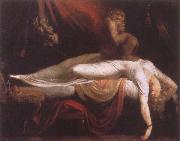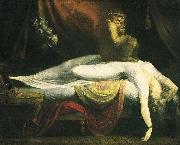
|
Johann Heinrich Fuseli
|
|||
|
|
|||
| 1741-1825 Romanticism Swiss | |||
|
|
|||
|
The Nightmare new16/Johann Heinrich Fuseli-265958.jpg Painting ID:: 40607 |
mk156 1781 Oil on canvas 101.6x127cm | ||
|
|
|||
|
Henry Fuseli
|
|||
|
|
|||
| Swiss-born British Romantic Painter, 1741-1825 Henry Fuseli was the first artist to command the epic literature and heroic history of northern Europe as well as the Mediterranean countries, and by his wide reading and close study of the Old Masters he equipped himself to extend the scope of history painting far beyond the traditional limits of the Bible and classical antiquity. In his speculative boldness he was a child of the Enlightenment, but he was also a fierce critic of sterile rationalism and preached the gospel of the imagination with religious fervor. Henry Fuseli was born Johann Heinrich F??ssli (in 1764 he Anglicized his name) in Zurich on Feb. 6, 1741, the son of a painter with strong religious convictions who destined him for the Zwinglian ministry. After a period of intensive theological study Fuseli was ordained in 1761 and preached his first sermon. He was a friend of Johann Kaspar Lavater, whose Aphorisms on Man he later translated into English from manuscript. Fuseli became the favorite disciple of Johann Jakob Bodmer, who in 1740 had published an essay on the wonderful in poetry that led to a literary war with Johann Christoph Gottsched in Germany and the formation of a revolutionary Swiss school which used English literature, especially Milton and Shakespeare, as a spearhead in promoting romanticism. | |||
|
|
|||
|
the nightmare new20/Henry Fuseli-764394.jpg Painting ID:: 56147 |
mk247 1781,oil on canvas,40x50 in,101x128 cm,detroit lnstitute of arts,detroit,mi,usa | ||
|
|
|||
|
Henry Fuseli
|
|||
|
|
|||
| Swiss-born British Romantic Painter, 1741-1825 Henry Fuseli was the first artist to command the epic literature and heroic history of northern Europe as well as the Mediterranean countries, and by his wide reading and close study of the Old Masters he equipped himself to extend the scope of history painting far beyond the traditional limits of the Bible and classical antiquity. In his speculative boldness he was a child of the Enlightenment, but he was also a fierce critic of sterile rationalism and preached the gospel of the imagination with religious fervor. Henry Fuseli was born Johann Heinrich F??ssli (in 1764 he Anglicized his name) in Zurich on Feb. 6, 1741, the son of a painter with strong religious convictions who destined him for the Zwinglian ministry. After a period of intensive theological study Fuseli was ordained in 1761 and preached his first sermon. He was a friend of Johann Kaspar Lavater, whose Aphorisms on Man he later translated into English from manuscript. Fuseli became the favorite disciple of Johann Jakob Bodmer, who in 1740 had published an essay on the wonderful in poetry that led to a literary war with Johann Christoph Gottsched in Germany and the formation of a revolutionary Swiss school which used English literature, especially Milton and Shakespeare, as a spearhead in promoting romanticism. | |||
|
|
|||
|
The Nightmare new20/Henry Fuseli-755579.jpg Painting ID:: 58889 |
The Nightmare, (1781) | ||
|
|
|||
|
Johann Heinrich Fuseli
|
|||
|
|
|||
| 1741-1825 Romanticism Swiss | |||
|
|
|||
|
The Nightmare new22/Johann Heinrich Fuseli-622773.jpg Painting ID:: 66529 |
Oil on canvas 101,6 ?? 127 cm 1781 | ||
|
|
|||
|
Louis Janmot
|
|||
|
|
|||
| (21 May 1814 - 1 June 1892) was a French painter and poet. Janmot was born in Lyon of Catholic parents who were deeply religious. He was extremely moved by the death of his brother in 1823 and his sister's in 1829. He became student at the Royal College of Lyon where he met Frederic Ozanam and other followers of his philosophy professor, Abbe Noirot. In 1831 he was admitted to the École des Beaux-Arts de Lyon and a year later, he won the highest honor, the Golden Laurel. In 1833, he came to Paris to take painting lessons from Victor Orsel and Jean-Auguste-Dominique Ingres. With other Lyon painters, he entered the Society of St. Vincent de Paul. In 1835, he went to Rome with Claudius Lavergne, Jean-Baptiste Frenet and other students and met Hippolyte Flandrin. After his come back to Lyon in 1836, Janmot would attract the attention of critics of the Salon de Paris in conducting large-scale paintings with religious inspiration such as The Resurrection of the son of the widow of Nain (1839) or Christ in Gethsemane (1840). After 1845, he attracted the interest of Charles Baudelaire with his painting Flower of the Fields that allowed him to access to the Salon of 1846. Theophile Gautier was impressed by his Portrait of Lacordaire (1846). But the failure of his Poem of the Soul at the Universal Exhibition of 1855 disappointed him. In December of that year he married Leonie Saint-Paulet, from a noble family in Carpentras. In 1856, Janmot obtained a commission to paint a fresco (since destroyed) representing the Last Supper for the church of St. Polycarp. Other orders followed, including the decoration of the dome of the Church of St. Francis de Sales and for the town hall that had been renovated by his friend the architect T. Desjardins. He was then appointed professor at the École des Beaux-Arts. | |||
|
|
|||
|
The nightmare new24/Louis Janmot-973737.jpg Painting ID:: 82922 |
Date 1854(1854) Medium Oil on wood cjr | ||
|
|
|||
|
Also Buy::. For Following Paintings / Artists / Products, Please Use Our Search Online: |












